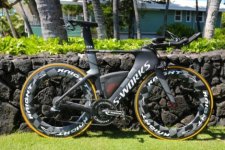Voltron
1 MW
Well, compared to the original put a set of aero bars on a regular frame days, the modern TT bikes have the rider position tilted way more forward, with the hips more over the pedals and shoulders over the armrests, and depending on your body shape is actually pretty comfortable. I never had my hands and wrists feel as good after a hour+ ride, and was peaking at 35 on the flats...its so gratifying to feel all the output from the pedaling going into motion and not drag that it inspires you to pedal harder then you ever have...
But thats exactly when it would be a waste to add 1500 watts, you could do it, the modern frames have evolved so much room inside the frame that they come with a big space for a water bladder that would hold a battery and a controller, and a rear disc to hide the motor, but unless you're on a groomed track with no need to stop quickly, and no traffic or pebbles or anything really in the way, going 45 with no suspension and 18mm wide tires is probably a bad idea.

But thats exactly when it would be a waste to add 1500 watts, you could do it, the modern frames have evolved so much room inside the frame that they come with a big space for a water bladder that would hold a battery and a controller, and a rear disc to hide the motor, but unless you're on a groomed track with no need to stop quickly, and no traffic or pebbles or anything really in the way, going 45 with no suspension and 18mm wide tires is probably a bad idea.


